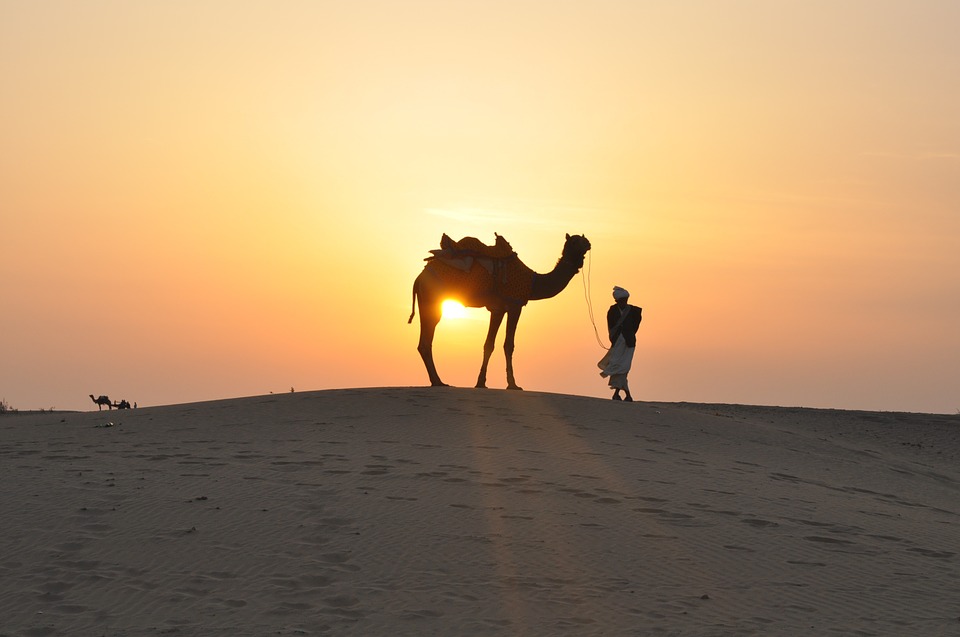干涸之地的生存专家
We know that water is an essential element for most of life on Earth,so species that survive in the world’s most arid environments really have their work cut out for them.Of all the desert animals,the camel is easily the most iconic.Whether they have one hump(Camelus dromedarius)or two(C.bactrianus),they can take on temperatures of over 40C and endure water losses greater than 25%of their total body weight.
我们知道,水是地球上大部分生命的必需元素。要在地球上最干旱的环境中生存,动物必须做好充分的准备。显然,骆驼是所有沙漠动物中最具有代表性的。无论是单峰骆驼还是双峰骆驼,都能够在40摄氏度以上的温度生存,而且在身体水分流失量达到总体重25%的情况下,还能维持生命。
To set the record straight,camel humps are not used for water storage–they are fatty deposits.While fat can be metabolised into water,animals in dry conditions lose too much moisture through respiration trying to get enough oxygen for the process to make it worthwhile.Instead,the fats can be used for nutrition when food is scarce.They also protect camels from the sun as the fatty tissue is slow to conduct heat and by locating most of their body fat on their back the animals carry less insulation elsewhere,helping to keep them cool.So,think of the humps as heat-shielding picnic parasols rather than flasks.
必须要澄清一点,骆驼的驼峰并不能用来储水——驼峰只是脂肪堆积而成的。虽然脂肪燃烧时会产生水,但在干燥环境下,动物会控制呼吸频率,只保证(维持生命所需的)最低脂肪消耗,因此呼吸带走的水分会更少。食物稀缺时,脂肪可用于营养供给。驼峰还可以帮助骆驼免受光照伤害,这是因为脂肪组织的导热速度慢,当身体大部分脂肪都囤积在背部时,其他部位的隔热脂肪较少,这也能保证他们更加凉快。因此,我们应该将驼峰视为野餐时的隔热遮阳伞,而不是背上的储水瓶。

While their humps are hard to ignore,some of camels’best features are internal.Scientists investigating the evolutionary background of camels have identified key physiological mechanisms that represent adaptations to the desert environment.
虽然驼峰很明显,但骆驼某些适应环境的特征来自于它们身体内部。在研究了骆驼的进化后,科学家已经确认了其适应沙漠环境而进化出的关键生理机制。
Due to highly efficient kidneys and intestines,camels lose very little water through waste.They pee very sporadically;their urine is super-concentrated,and their droppings are exceptionally dry.Their red blood cells are also specially adapted to cope with fluctuating hydration:they can expand to 240%of their initial volume,whereas other species’will burst beyond 150%.Camels’red blood cells are also smaller and oval shaped,meaning they can flow more easily even when the blood is thickened through extreme dehydration.
骆驼的肾脏和肠道运作效率很高,因此排泄时仅会损失很少的水分。骆驼很少排尿;尿液浓度很高,粪便特别干燥。它们的红细胞也经历了进化,以应对时多时少的水合作用:骆驼的红细胞可以扩展到初始体积的240%,其他物种的红细胞体积扩张到150%后就会爆炸。骆驼的红细胞较小且呈椭圆形,这意味着即使血液因极度脱水而变稠,红细胞也可以更容易地流动。
For our most indefatigable species then,the secrets of survival in hostile conditions are literally in the blood.
这种最不知疲倦的物种,其在极端条件下生存的秘密,其实就藏在他们的“血液”里。







